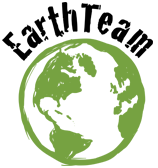 Michelle Espino is deeply committed to environmental and social justice. She teaches English Language Arts to 9th and 10th graders at Castlemont High School and is part of/collaborates with Castlemont’s Sustainable Urban Design Academy (SUDA). When you speak with her students you find them describing the connections between what they throw into the garbage at school, and both the trash vortex in the middle of the Pacific Ocean and the economic disenfranchisement their community faces. In response to the question “Why do you think it’s important to recycle” a student responded “Because if you don’t recycle, the recycling that you throw away in the trash is going go to the ocean. Therefore, animals and other plants can die because the ocean’s getting polluted.” Another student added that “Landfills pollute our air and if we don’t dispose of our trash properly it just pollutes the waters and gets into the Pacific or Atlantic Ocean where the trash vortex [is]…” What one student found most interesting was that “the trash vortex was the size of Texas….”
Michelle Espino is deeply committed to environmental and social justice. She teaches English Language Arts to 9th and 10th graders at Castlemont High School and is part of/collaborates with Castlemont’s Sustainable Urban Design Academy (SUDA). When you speak with her students you find them describing the connections between what they throw into the garbage at school, and both the trash vortex in the middle of the Pacific Ocean and the economic disenfranchisement their community faces. In response to the question “Why do you think it’s important to recycle” a student responded “Because if you don’t recycle, the recycling that you throw away in the trash is going go to the ocean. Therefore, animals and other plants can die because the ocean’s getting polluted.” Another student added that “Landfills pollute our air and if we don’t dispose of our trash properly it just pollutes the waters and gets into the Pacific or Atlantic Ocean where the trash vortex [is]…” What one student found most interesting was that “the trash vortex was the size of Texas….”
The ninth grade students working on this project made connections to work they did in their science class on sustainable energy. This included scientific perspectives on recycling and a unit on sustainable energy where students analyzed their environmental impact in terms of the amount of CO2 they add to the atmosphere through their commutes to school. They then developed plans for reducing the amount through forming groups to walk, bike, carpool to school, and calculated the amount of reduced CO2.
The recycling project also enabled students to link what they learned in Michelle’s and their science teacher’s classes to an action where they could see not only the impact on the environment, but the economic impact on the people in their community. “I like that the classrooms is a lot cleaner and that people are actually using the recycling. So it wasn’t a waste of time. We’re not only helping the environment, but the people. There’s some people that come in and when we’re taking the recyclings out, they come in and ask for the bottles or cans. So they go and sell them and we’re also helping them ‘cause we sort their things out.”
You’ll also hear the students talk enthusiastically and in great detail about decorating the recycling bins they placed in different classrooms. One component of the recycling project was to decorate the recycling bins with designs created from different color tapes. One student created a Raiders-themed bin for a teacher he knew was a big Raiders fan. Michelle observed that her students felt a sense of investment in the recycling project because of having decorated the recycling bins. “The kids were really into that and I think it allowed them to really invest, because then when they went into classrooms they definitely…thought it was like a piece of their own artwork.”
Michelle had some concerns about including this component – that it might take away from time better spent on developing skills. This was of particular concern because Michelle was doing the project in her Strategic classes for the first time. “…normally…Strategic should be about skills.” But she found a way to combine skill, knowledge building, creativity, and action within the larger recycling project. This was in part accomplished through collaboration with a community partner (Earth Team) and the science teacher at Castlemont.
recycling project. This was in part accomplished through collaboration with a community partner (Earth Team) and the science teacher at Castlemont.
What was clear from speaking with students was that the decorated bins were a tangible way to connect to the ideas and practices of environmental justice. Students recognize the lack of resources in their schools and community; they live with violence and economic disenfranchisement. The social issues that come up in classroom discussions include discussions of the abandoned buildings, the vacant lots, and shootings in the Castlemont neighborhood. Creating the bins is a concrete, tangible step towards building, renewing, and taking ownership of their community.
Michelle kicked off Year 2 of the recycling project with Castlemont seniors – Enviro-Knights from SUDA – leading 9th graders participating in the project through a trash audit. Students sorted through trash and learned what was recyclable and what was not. One student gathered data and another interviewed students. Michelle reported that more students participated in the student-led trash audit than did last year when it was lead by a community partner.